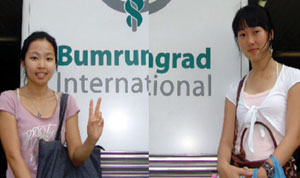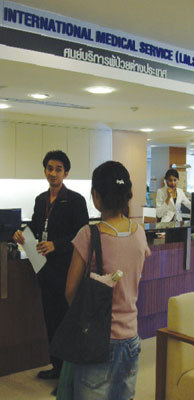
Senior, College of Law
I went to Bangkok and Singapore to do research on the international hospitals which have made those cities the medical hubs of Southeast Asia. Recently, Jeju Special Self-Governing Province announced that JeJu would attempt to become a medical-hub city. The government has earmarked certain cities as medical hubs and Jeju Island was included because of its importance as a Northeast Asia-tourism destination. My partner Bo-mi and I heard this news when we were preparing to enter the 'Window to the World' program. We submitted a project about the possibility of Korea becoming a Northeast Asia-medical hub and we won.
First of all, we visited Raffles Hospital in Singapore famous for its Siamese twin separating-operations. It was established in 2001 and targets wealthy patients from Japan and China. Before going there, I had no idea that it was such a huge and luxurious hospital. It was so clean and had many kinds of restaurants for many different groups such as Muslims, Chinese, and Indonesians.

Singapore is made up of 'towns' such as India-town, Muslim-town, China-town, and Indonesia-town so I was able to experience a lot of different cultures and life styles in one place. However, I was a little confused as to what the 'real' Singapore was. Many of the citizens were from different nations and used different languages. Every signboard in Singapore was written in four different languages Arabic, Chinese, Indian, and English. Announcements on the subway were also made in four different languages. These groups have lived together peacefully and respectfully so I thought that if people could understand their own differences, the world would be more harmonious.

-Talking with a Korean interpreter
Next, we visited the Thai Bumrungrad Hospital which is normally used by the Thai royal family. Foreign patients, especially Chinese and Japanese, are assigned doctors who can speak their languages and can therefore communicate with them easily. When I arrived there, I was surprised at the large number of people who worked at the hospital. At the front entrance, there were no less than seven people just helping visitors to call taxis and opening the taxi-doors for them. I concluded that Thailand was more competitive than Singapore not only because of its superior tourist attractions but also because of the many customer-services it provided thanks to its cheap human-labor costs. Bumrungrad Hospital has many convenient facilities such as a 'Starbucks' cafe, huge wide lounges, restaurants, and a traditional Thai-massage center on the first floor. On the second floor, there were administration offices, an information center, and a Tsunami-memorial exhibition.
If a patient needs to extend his or her visa, an administration officer will take care of the paperwork. The most impressive area was the Tsunami-memorial exhibition. It was not so big but there were many pictures of the disaster and some mementos left behind by the casualties such as shoes, hats, and babies' dolls which babies were probably holding just before the Tsunami struck. Through this exhibition, they hope to remember the disaster and to prevent it from happening again.

The Bangkok Hospital-Talking with a Korean interpreter
The wards were situated on the upper floors, so that patients were not disturbed by the noise created by the visitors.
Finally, we visited the Bangkok International Hospital. It provides 35 language-interpreters to communicate with foreign patients and offers tours of the city. Even though its facilities were not as good as those of the Bumrungrad Hospital, the employees were the kindest I had ever met at any hospital. When I asked if I could have some information about the hospital, they immediately called a Korean interpreter so that I could obtain more details such as the price of examinations and charges for hospital accommodation.
For Korean patients, they discount 30 percent from hospital charges and provide a free Bangkok City-tour. There were also Chinese and Japanese centers.

When I arrived at the Bangkok International Airport, I smelled fog. Before I went to Bangkok, my friend, who had been to Thailand before, had advised me that if I smelled some weird scent when I arrived in the city, then I would be in trouble. I didn't know if was true.
Even though I lost some money during the journey, it was a great experience. Usually, I travel by myself and so I had been a bit lonely but this time, I was not alone. I really want to thank my partner, Bo-mi Gong. I really appreciated traveling with her and I hope she lives well in Japan next semester.


